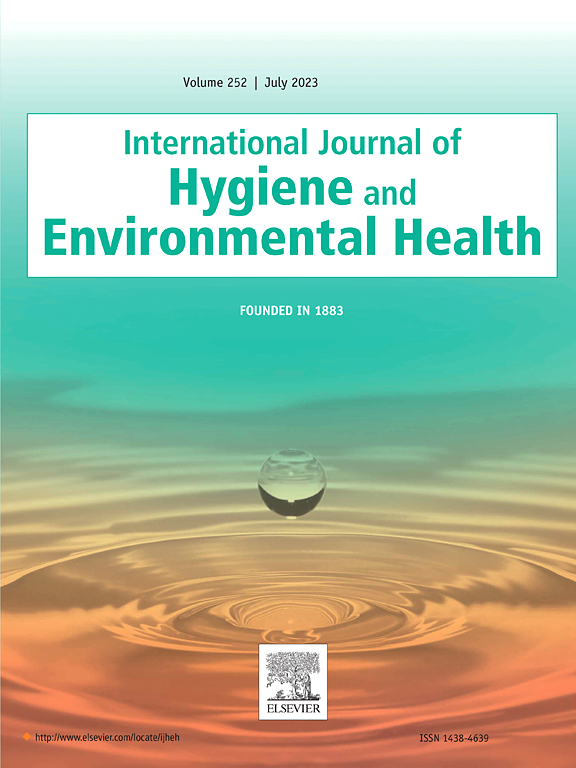Barriers and enablers for group-based manual emptying services for onsite sanitation facilities in Nairobi, Kenya: a qualitative study
IF 4.4
2区 医学
Q1 INFECTIOUS DISEASES
International journal of hygiene and environmental health
Pub Date : 2025-05-16
DOI:10.1016/j.ijheh.2025.114595
引用次数: 0
Abstract
Onsite sanitation, such as pit latrines, is essential to achieving universal access to safe sanitation, as outlined in Sustainable Development Goal target 6.2. However, manual emptying for pit latrines in low-income areas is often unhygienic, posing health and environmental risks. Enhancing the safety of these services increases costs, yet affordability for customers is essential. Thus, reducing service costs is a key priority. Group-based approach, where emptiers visit multiple toilets consecutively, has potential to improve both service efficiency and affordability. However, few studies have investigated its applicability to manual emptying. This paper aims to identify barriers and enablers for group-based manual emptying services in low-income neighbourhoods of Nairobi. We conducted 12 focus group discussions with landlords, tenants, and manual emptiers in the Korogocho informal settlement in Nairobi and interviewed 20 key informants from relevant sectors in Kenya. We identified five categories of barriers and enablers that affected general and group-based manual emptying: 1) funding, 2) expertise and equipment, 3) social and commercial habits, 4) physical conditions, and 5) regulatory systems. Of these, a norm that pits are not emptied until they get full, operating time constraints, fair and transparent pricing, and an organiser who can arrange group-based emptying from Category 3, and transport capacity from Category 4 specifically affected group-based manual emptying. Given that the barriers have a cascade structure, addressing some primary barriers such as capacity building and recognising manual emptiers’ role in the sanitation policies could be effective ways to ensure safe and affordable emptying services.

肯尼亚内罗毕现场卫生设施群体人工排空服务的障碍和推动因素:一项定性研究
如可持续发展目标具体目标6.2所述,现场卫生设施,如坑式厕所,对于普遍获得安全卫生设施至关重要。然而,在低收入地区,人工排空坑式厕所往往不卫生,造成健康和环境风险。提高这些服务的安全性会增加成本,但客户的负担能力是至关重要的。因此,降低服务成本是一个关键的优先事项。以群体为基础的方法,即清空者连续访问多个厕所,有可能提高服务效率和可负担性。然而,很少有研究调查其对手动排空的适用性。本文旨在确定内罗毕低收入社区以群体为基础的人工清空服务的障碍和推动因素。我们与内罗毕科罗戈乔非正式定居点的房东、租户和手工清空者进行了12次焦点小组讨论,并采访了来自肯尼亚相关部门的20名关键线人。我们确定了影响一般和基于群体的手工排空的五类障碍和促成因素:1)资金,2)专业知识和设备,3)社会和商业习惯,4)物理条件,以及5)监管系统。其中,坑满后才排空的规范、操作时间限制、公平透明的定价,以及组织者可以安排第三类的分组排空,以及第四类的运输能力,特别影响了分组手动排空。鉴于这些障碍具有级联结构,解决一些主要障碍,如能力建设和承认人工清空者在卫生政策中的作用,可能是确保安全和负担得起的清空服务的有效途径。
本文章由计算机程序翻译,如有差异,请以英文原文为准。
求助全文
约1分钟内获得全文
求助全文
来源期刊
CiteScore
11.50
自引率
5.00%
发文量
151
审稿时长
22 days
期刊介绍:
The International Journal of Hygiene and Environmental Health serves as a multidisciplinary forum for original reports on exposure assessment and the reactions to and consequences of human exposure to the biological, chemical, and physical environment. Research reports, short communications, reviews, scientific comments, technical notes, and editorials will be peer-reviewed before acceptance for publication. Priority will be given to articles on epidemiological aspects of environmental toxicology, health risk assessments, susceptible (sub) populations, sanitation and clean water, human biomonitoring, environmental medicine, and public health aspects of exposure-related outcomes.

 求助内容:
求助内容: 应助结果提醒方式:
应助结果提醒方式:


